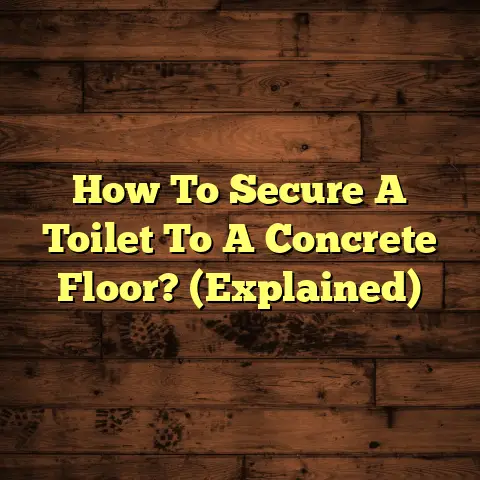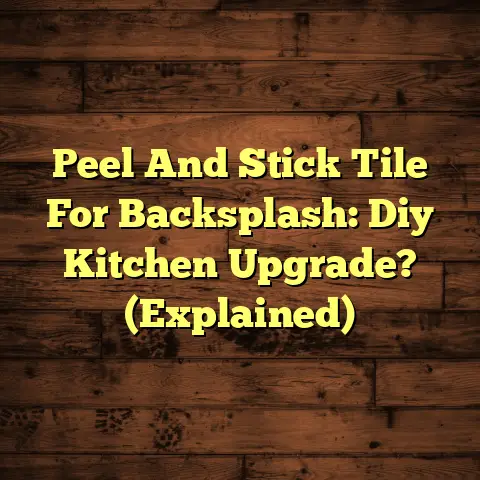How To Clean And Polish Slate Tile Floors Safely? (Explained)
I remember the first time I installed slate tile floors in my home. The rich, earthy tones and unique textures of the tiles fascinated me. However, after a few months, I noticed they started to lose their luster. I was disheartened; I thought I had made a mistake. That’s when I realized that maintaining these beautiful tiles required a bit of knowledge and effort. Over the years, I’ve learned how to clean and polish slate tile floors safely, and today, I want to share that journey with you.
The Importance of Regular Maintenance
Keeping slate tile floors looking their best isn’t just about aesthetics; it’s also about protecting your investment. Slate is durable, but dirt, grime, and stains can accumulate over time. Regular maintenance helps preserve its natural beauty and extends its lifespan.
What You’ll Need for Cleaning Slate Tile Floors
Before diving into the cleaning process, let’s gather the necessary supplies:
- Broom or vacuum: For dust and debris removal.
- Mop: A microfiber mop works best to lift dirt without scratching.
- Bucket: For mixing your cleaning solution.
- pH-neutral cleaner: Ensure it’s safe for slate.
- Soft cloths or towels: For drying and polishing.
- Sealer: If your slate needs resealing, this is crucial.
Cleaning Slate Tile Floors
Step 1: Sweeping or Vacuuming
I always start by sweeping or vacuuming the floor to remove loose dirt and debris. A vacuum with a soft brush attachment works wonders. When I first started, I didn’t think this step was vital, but trust me, it makes a huge difference in the cleaning process.
Step 2: Preparing Your Cleaning Solution
Next, I mix a solution of warm water and a pH-neutral cleaner in a bucket. It’s important not to use harsh chemicals or acidic cleaners as they can damage the slate. Always read the labels; I learned this the hard way when I used a vinegar solution that left dull spots on my beautiful tiles.
Step 3: Mopping
With my solution ready, I dip the microfiber mop into the mixture and wring it out thoroughly. Too much water can seep into the grout lines and damage them over time. I mop in sections, making sure to rinse my mop frequently to avoid spreading dirt around.
Step 4: Drying
After mopping, I use soft towels to dry the floor. This step is crucial because it prevents water spots from forming. If you leave your floors wet, you might end up with more work later on.
Step 5: Polishing
Once the floor is dry, it’s time to polish. I use a soft cloth and a stone-safe polish specifically made for slate. Applying a thin layer and buffing it in small circular motions gives the tiles a beautiful sheen. When I first polished my floors, I was amazed at the transformation!
Resealing Slate Tile Floors
Slate can absorb moisture and stains if not properly sealed. Depending on your foot traffic and wear, resealing may be necessary every 1-3 years.
Step 1: Cleaning Before Sealing
Before applying sealer, ensure the floor is thoroughly cleaned and dry. Any residue left will interfere with adhesion.
Step 2: Applying Sealer
Using a roller or sprayer, apply an even coat of stone sealer over the tiles. Follow the manufacturer’s instructions regarding drying times. I usually give it a full day before walking on it again.
Tips for Maintaining Slate Tile Floors
- Immediate Cleanup: If you spill something, clean it up right away to avoid staining.
- Avoid Scratching: Place mats at entry points to catch dirt and debris.
- Use Coasters: For furniture, coasters can prevent scratches and dents.
- Regular Inspections: Check for signs of wear or damage regularly.
Challenges I’ve Faced
The road hasn’t always been smooth. I once forgot to reseal my slate floors for several years, leading to some unsightly stains that took professional help to fix. It was costly, but it taught me an invaluable lesson about regular maintenance.
Another challenge was finding the right products that worked well with my specific type of slate. Experimenting with different cleaners led to some trial and error before discovering what worked best for my situation.
Comparing Cleaning Approaches
In my experience, I’ve tried various cleaning methods:
- Steam Cleaning: While it’s effective for deep cleaning, it can risk damaging the grout if not done correctly.
- Homemade Solutions: I’ve experimented with baking soda and water paste for spot cleaning; while it worked in some instances, it wasn’t always reliable.
I found that sticking with a pH-neutral commercial cleaner gave me the best results without the risk of damage.
Cost Considerations
Cleaning and maintaining slate floors doesn’t have to break the bank. Most of the supplies are affordable—cleaners generally range from $10 to $30 a bottle, while sealers can cost around $25 to $50 depending on the brand and coverage area.
When using FloorTally for estimating costs related to flooring projects, it provides me with accurate local pricing for materials and labor. This tool has helped streamline budgeting for maintenance tasks as well, allowing me to plan ahead effectively.
Final Thoughts
Cleaning and polishing slate tile floors may seem daunting at first, but once you get into a routine, it becomes second nature. The key is consistency and using the right products.
Have you had any experiences with slate tiles? What methods have worked for you? I’m always eager to hear new tips or tricks! Remember, maintaining those beautiful slate floors not only enhances your home’s beauty but also protects your investment for years to come.
Understanding Slate Tile Floors
Slate tiles are celebrated for their unique aesthetics and durability. Each piece has its own character due to its natural formation process. This diversity means that no two tiles are alike, creating a distinct look in any space they occupy.
Why Choose Slate?
I opted for slate because of its natural slip resistance and thermal properties. It’s perfect for areas like kitchens and bathrooms where spills are common. Additionally, its ability to hold heat makes it ideal for sunrooms or spaces where warmth is desirable.
Added Benefits of Slate Flooring
One thing I love about slate is its longevity. When cared for properly, these tiles can last a lifetime. Unlike other flooring options that may need to be replaced every couple of decades, slate can be refinished instead of replaced.
Moreover, slate is eco-friendly as it’s derived from natural stone—no synthetic materials involved! Choosing slate contributes to sustainability efforts in home design.
The Installation Process of Slate Tile Floors
When I first decided to install slate tile floors, I did extensive research on the installation process since it’s crucial to get it right from the start.
Preparing the Subfloor
Before laying down any tiles, ensuring a solid foundation is key. I checked my subfloor for any imperfections or moisture issues that could affect the installation.
Laying Out Tiles
It’s essential to plan your layout before starting installation. I spent time arranging tiles without adhesive to determine how they fit together best. This step helped me visualize how the final project would look.
Applying Adhesive
For installation, I used a thin-set mortar that’s compatible with natural stone tiles. It’s important not to use too much adhesive; otherwise, it can squish up through the grout lines when pressing down on the tiles.
Grouting Between Tiles
After allowing the adhesive to cure (which usually takes about 24 hours), I mixed my grout and applied it between the tiles using a rubber float. Clean-up was essential here; any excess grout left on the surface could become difficult to remove later.
Dealing with Common Issues During Installation
While installing my slate tiles, I encountered various challenges:
- Uneven Tiles: Some tiles were thicker than others; this created an uneven surface that required careful adjustments.
- Stains from Grout: One time, grout stained my newly installed tiles before I had applied sealer! It took quite a bit of scrubbing to restore them.
- Cuts and Breaks: Cutting slate requires patience; not all pieces break evenly, which can lead to waste if you’re not careful.
These challenges taught me that preparation and patience are vital during installation.
Advanced Maintenance Techniques
Once installed and cleaned regularly, sometimes additional maintenance methods may be necessary:
Deep Cleaning with a Machine
For heavy-duty cleaning tasks, renting a floor cleaning machine can be beneficial. I did this once when my floors had accumulated grime after hosting several parties. The machine effectively removed dirt embedded in the tile texture without damaging them.
Professional Restoration Services
If your slate tiles have seen better days despite your best efforts, consider hiring professionals for restoration services such as honing and polishing that can revive their original shine.
Seasonal Maintenance Tips
Different seasons can bring various challenges for maintaining slate tile floors:
- Winter: In snowy areas, salt can be damaging when tracked indoors. Ensure mats are placed at entrances to capture salt before it reaches your floors.
- Summer: High humidity can lead to mold growth in damp areas like bathrooms; ensure proper ventilation and regular cleaning.
- Fall: Leaves can create slippery surfaces when wet; make sure to sweep often during this season.
Enhancing Aesthetic Appeal
While functionality is important, enhancing your slate tile floors’ aesthetic appeal adds value to your home:
Area Rugs
Strategically placing area rugs can add warmth while protecting your tiles from scratches or scuffs caused by furniture movement.
Accent Lighting
Consider installing accent lighting that highlights the natural textures of your slate tiles; this can create an inviting atmosphere in any room.
Conclusion
Cleaning and maintaining slate tile floors may seem daunting at first, but once you get into a routine, it becomes second nature. The key is consistency and using the right products.
Have you had any experiences with slate tiles? What methods have worked for you? I’m always eager to hear new tips or tricks! Remember, maintaining those beautiful slate floors not only enhances your home’s beauty but also protects your investment for years to come.
Through all my trials—both successful and challenging—I’ve learned that dedication goes a long way in preserving the integrity of these stunning floors in my home. By sharing my experiences with you today, I hope you feel more empowered to tackle your own slate tile cleaning and maintenance tasks confidently!





